AMS 105- American West: Images and Identities
|
AMS 105- American West: Images and Identities |
Transportation
Many Native Americans and early explorers made their way on foot. Many of the Plains tribes referred to their early days as the 'dog days' when they had no horses and dogs or people pulled extra equipment on a drag or 'travois'. Sometimes various kinds of boats from dugout to canoe were use to cross or go down rivers or lakes. When Europeans came to the West they brought various hoofed animals to include oxen/cattle/donkeys/mules, camels and the most important the horse.
Horse
The tradition of the Western horse began when the Spanish brought the horse, in domestic form, back to its place of origin, America. Of the many things exchanged in what is referred to as the Columbian Exchange, the return of the horse was one of the most significant. The Western horse was derived from Spanishand North African breeds that were variously modified to meet the needs of vaqueros/cowboys in the Southwest, California, Plains and later into mountain regions of the Rockies and the Northwest. However, when horses escaped and survived on their own they became known as "mesteño" or mustangs. Mustangs became rather 'wild' but they are actually still a domestic animal gone feral. The horse had originated in America 55 million years ago and became a wild Equus sp. about 1.6 million years ago and physically was similar to a zebra. A few million years ago these truly wild horses migrated to the Eurasia and Africa. In America the true horses became extinct by 10,000 years ago. Some believe actual wild horses may have held out in the interior of British Columbia. In Eurasia and Africa horses were domesticated (5,000 years ago +) and the domestic horse Equus caballus arrived back in America in 1519. In Spanish colonial times mustangs interbreed on their own while Native Americans and settlers recaptured many mustangs to breed with various Eastern breeds like Morgan and Thoroughbred. Military and wagon pulling horses would be further mixed with Percheron or Clydesdales in the Rockies and Oregon country. The Nez Perce developed their own mountain horse called the Appaloosa, that was later used by settlers. Much later a fast short distance horse breed was derived from Mustangs and Eastern horses for racing in a quarter mile which was referred to as a Quarter Horse. In California the Palomino enjoyed a notoriety and was somewhat isolated.
| Spanish (sometimes called Andalusian); Arabian and Barb mixed in over time in Spain; 15-16 hands (height); compact; used in formal riding academies like Lippazzan |
 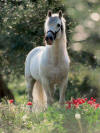 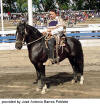 |
| Arabian; a desert horse with ancient roots in N. Africa especially among Bedouin 14-15 hands with a unique wedge shaped head and sometimes only 5 lumbar vertebrae; showy tail. Often used in shows and circuses. |
 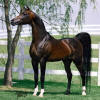  |
| Thoroughbred; English/Arabian, 15-17 hands, lean and long legs |
   |
| American Quarter;
English/East coast bred for short distance; 14-16 hands more compact and agile. Brought out West for cowpunching. |
   |
| Palomino; more a color breed
with golden as an ideal derived from various breeds. Roy Roger's Trigger was a Palomino. |
  |
| Appaloosa; a breed with color variation noted in Asia, but redeveloped in America by the Nez Perce as a mountain horse (stocky chest) 15-16 hands with 'leopard spots'; ranchers preserved and revitalized the breed after Nez Perce lost so many horses after 1877. |
   |
| Morgan; compact 14-15 hands derived from a single horse in Mass.; saddle horse and trotter |
  |
| Percheron; French battle mounts for knights in medieval times and then became work/ carriage team horses 15-19 hands |
   |
| Clydesdale; large work or draft horse from Scotland 16-18 hands, used to showcase old Budweiser Wagons. |
 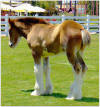  |
| Mustang; feral (free roaming) horses. Supposedly began with the release of Spanish horses and burros in the 1500s. Then any strays or Mavericks, Indian ponies and rustled horses were mixed in over the years. Currently these Mustangs are on the rise and being 'managed' by the Bureau of Land Management, BLM. (BLM program) |
   |
Horses were bred for
various size or behavioral traits as well as for color.
Color
and markings often were connected to superstitions about behaviors. Expected
coloration did not always remain consistent, but various color combinations
arose from all these hybrids. White horses were considered weak, pintos were
small, blacks suffered from heat, bays were vicious and chestnuts were thin
skinned. Native Americans in the Plains, like the Kiowa, Comanche, Lakota and
Blackfeet preferred different types and colors
 especially paints and pintos.
Horses used by cowboys could be derived from Spanish vaquero horses many types
were added based on preferences of appearences, breed or skills. Generally, the
cow horses or ponies had to be hardy and smaller for the work needed...see
below.
especially paints and pintos.
Horses used by cowboys could be derived from Spanish vaquero horses many types
were added based on preferences of appearences, breed or skills. Generally, the
cow horses or ponies had to be hardy and smaller for the work needed...see
below.
| TYPE / NAME | CHARACTERISTICS |
| mustang, Cayuse, bronco | wild or unbroken; 'mockey' was a wild mare; 'manda' is aband of mares with a lead stallion |
| cow horse | experience with cattle |
| work horse | experience in a harness/ pulling a wagon, etc |
| stallion | fertile male horse |
| mare | fertile female horse (technically 5 yrs+); 'foal' is baby horse, 'colt' is a young horse ('potros' in Span) |
| gelding | a castrated stallion |
| fuzz-tails/ fuzzies | range horse |
| willow tail | long loose tail; 'ratail' is short or little hair |
| top horse | a skilled horse in multiple skills of roping and cutting; as opposed to a day herding horse with lesser skills |
| jug-head, churn-head | not very smart |
| spoiled horse | outlaw, spoiled in breaking |
| salty bronc, spooky, snaky | a bad horse |
| plug, shad-bellied, buzzard-bait | a broken down horse |
| wind-bellied, grass-bellied, pot-gutted | bloated on grass |
| cutting horse | highly trained to cut out cattle, this horse was able to turn sharply and the cowboy had to stay on |
| rope horse | highly trained to be the right distance for the release of the rope/lasoo (rietta in Spanish) and to maintain tension on the rope |
| night horse | a horse that was calm with sense of direction and keen eyesight to find their way home in the dark |
| swimming horses | a good swimmer and guide for spooky cattle in river crossings |
| remuda, string, cavvy (short for caballada), saddle band | each cowboy at a ranch or drive was issued a 'string' of horses that performed the various tasks or skills in working or driving cattle |
| maverick | a loose range horse with no brand, actually based on a lawyer,
Samuel A. Maverick, who kept a herd of unbranded horses on the San
Antonio R. in Texas |
Much of the use of the horse or the Western horse was primarily based on the
limited time of the open range opportunity after the Civil War. Explorers and
ranches existed before the Civil War and the Spanish vaquero
 and Anglo cowboys
and Anglo cowboys
 worked cattle, but in the open ranges of Texas the roundups and drives of beef
cattle reached a peak before the Civil War. Roundups were usually in the Spring for branding and Fall
for the Big Drives to the north. It was in these roundups that the cowboy used a
String or Remuda to perform all the needed tasks. A 'chuck' wagon went on drives and provided food. The introduction of
fencing laws and barb wire greatly changed the role of the cowboy. A severe blizzard in
1886-87 decimated many ranches in the Northern Plains. The Western horse was
kept alive with wild west shows and the rodeo.
worked cattle, but in the open ranges of Texas the roundups and drives of beef
cattle reached a peak before the Civil War. Roundups were usually in the Spring for branding and Fall
for the Big Drives to the north. It was in these roundups that the cowboy used a
String or Remuda to perform all the needed tasks. A 'chuck' wagon went on drives and provided food. The introduction of
fencing laws and barb wire greatly changed the role of the cowboy. A severe blizzard in
1886-87 decimated many ranches in the Northern Plains. The Western horse was
kept alive with wild west shows and the rodeo.
Horses and mules were also used in 'Pack Trains" especially through mountain
passes. The donkey was reliable but rather small
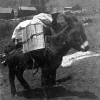 and the mule ( a usually
sterile hybrid of a horse and a donkey) was larger
and the mule ( a usually
sterile hybrid of a horse and a donkey) was larger
 and yet more sure footed than
a horse. Donkeys were often used by lone prospectors
and yet more sure footed than
a horse. Donkeys were often used by lone prospectors while pack mules were used
by regular expeditions, couriers and the military. Mule skinners were those that
packed and drove the mules. You can still take a mule ride into the Grand
Canyon
while pack mules were used
by regular expeditions, couriers and the military. Mule skinners were those that
packed and drove the mules. You can still take a mule ride into the Grand
Canyon ...good luck. Mules were also an alternative to oxen for pulling a plough,
especially in the South. The U.S. military used horses, mules and camels before
and after the Civil War. The horses were varied, depending on the supplier, but
there was a tendency to import larger Eastern breeds, such as Morgan and
Thoroughbred. For a very short time the US Mail was carried by a unique relay
system called the Pony-Express. The run was from St. Joseph, MO to
Sacramento, CA (1,966 miles with 190 way stations). Riverboats completed the
journey to San Francisco. The riders carried small locked pouches, called mochilas, that carried the letters. They made the journey in 10 days , which
was half the stage runs of 22+ days. However, the Pony Express operated only
from 1861-1862 and was replaced by the telegraph.
...good luck. Mules were also an alternative to oxen for pulling a plough,
especially in the South. The U.S. military used horses, mules and camels before
and after the Civil War. The horses were varied, depending on the supplier, but
there was a tendency to import larger Eastern breeds, such as Morgan and
Thoroughbred. For a very short time the US Mail was carried by a unique relay
system called the Pony-Express. The run was from St. Joseph, MO to
Sacramento, CA (1,966 miles with 190 way stations). Riverboats completed the
journey to San Francisco. The riders carried small locked pouches, called mochilas, that carried the letters. They made the journey in 10 days , which
was half the stage runs of 22+ days. However, the Pony Express operated only
from 1861-1862 and was replaced by the telegraph.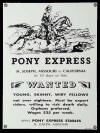
Wheeled-vehicles
There were many kinds of carts and wagons that were pulled by
single or teams of animals. Native Americans did not have wheeled carts
(although they had wheeled toys). Therefore, Europeans introduced various carts
and wagons. The Spanish brought a simple two wheeled cart called a 'caretta'.
 The wheel was easy to make because it was rimless and spokeless, cut from a
slab of oak. Usually carretas were pulled by oxen and were rather slow that
limited them to local travel. Most
of the Spanish Expeditions and travel was conducted on horse along the old 'camino
reals' or royal roads between Mexico and the Northern frontier areas like New
Mexico and California. Highway 101 basically follows the old El Camino Real from
San Diego Mission to San Raphael Mission above San Francisco. In the
French Canadian West a small cart called a 'pembina' was used but differed from
the caretta in that it had spoke wheels. Anglo-Americans poured into the West on
their wagon trains beginning in the early 1840s following the Oregon Trail,
Immigrant Trail, Mormon Trail, and Santa Fe trail. The dominant wagon for the
early pioneer was the Conestoga wagon or 'prairie schooner', which was a four
wheeled wagon developed by Pennsylvania Dutch initially for the Great Wagon Road
and later were made to travel over the Cumberland Gap and finally out into the West. It had various
features to include out turned wheels, a rain tarp, a stable load carry
configuration, and a steerable front axle. The Conestoga carried a lot of weight
and due to its design was somewhat defendable. Many immigrant families made
their way West from 1840-1870, so many, that wagon rut marks are still visible on
some of the old trails.
The wheel was easy to make because it was rimless and spokeless, cut from a
slab of oak. Usually carretas were pulled by oxen and were rather slow that
limited them to local travel. Most
of the Spanish Expeditions and travel was conducted on horse along the old 'camino
reals' or royal roads between Mexico and the Northern frontier areas like New
Mexico and California. Highway 101 basically follows the old El Camino Real from
San Diego Mission to San Raphael Mission above San Francisco. In the
French Canadian West a small cart called a 'pembina' was used but differed from
the caretta in that it had spoke wheels. Anglo-Americans poured into the West on
their wagon trains beginning in the early 1840s following the Oregon Trail,
Immigrant Trail, Mormon Trail, and Santa Fe trail. The dominant wagon for the
early pioneer was the Conestoga wagon or 'prairie schooner', which was a four
wheeled wagon developed by Pennsylvania Dutch initially for the Great Wagon Road
and later were made to travel over the Cumberland Gap and finally out into the West. It had various
features to include out turned wheels, a rain tarp, a stable load carry
configuration, and a steerable front axle. The Conestoga carried a lot of weight
and due to its design was somewhat defendable. Many immigrant families made
their way West from 1840-1870, so many, that wagon rut marks are still visible on
some of the old trails.
Conestoga Wagons
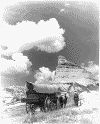 |
 |
 |
A derivative wagon, called the Santa Fe Wagon,
was like the Conestoga wagon, but was larger and pulled by 3-4 yolks of
oxen or mules. Large trains of Santa Wagons were used after 1821 from St. Louis
down to Santa Fe and in 1848 when New Mexico became part of the US these trains
were more common. A more luxurious mode of wheeled travel came in the form of
the Overland or Stage Coach, that were derived from England and the East coast.
These made their appearance in the West in 1820 and came in various forms, with
the Concord coach being the most common style.
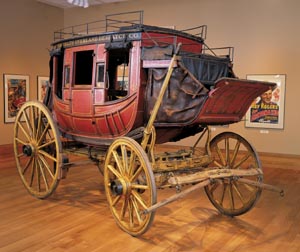 Initially, these coaches provided passenger
service but later provided mail service. The Overland Mail Company (or
Butterfield Stage)
Initially, these coaches provided passenger
service but later provided mail service. The Overland Mail Company (or
Butterfield Stage)
 ran from New Mexico to California and Wells, Fargo and
Company prevailed in the North with San Francisco runs to the gold fields,
Virginia City (Nevada) and points east. Individuals or gangs of 'road
agents' plagued these runs robbing passengers and the mail. On of the most
famous of these road agents was "Black Bart" (C. E. Bolton) who was active in
California. Some of these road agents successfully used dummy figures placed in
bushes at the ambush site to create a gang and reduce any hesitation from the
unsuspecting passengers and driver. There were many smaller buggies used
in towns or for local travel, such as
buckboards, surreys, hand carts and special hearses that were used in the West.
In the 1870s the 'wheelmen' craze emerged with of all things the bicycle and
this in turn was the impetus to get local roads improved in the early part of
the 20th century. Healdsburg, CA wheelmen:
ran from New Mexico to California and Wells, Fargo and
Company prevailed in the North with San Francisco runs to the gold fields,
Virginia City (Nevada) and points east. Individuals or gangs of 'road
agents' plagued these runs robbing passengers and the mail. On of the most
famous of these road agents was "Black Bart" (C. E. Bolton) who was active in
California. Some of these road agents successfully used dummy figures placed in
bushes at the ambush site to create a gang and reduce any hesitation from the
unsuspecting passengers and driver. There were many smaller buggies used
in towns or for local travel, such as
buckboards, surreys, hand carts and special hearses that were used in the West.
In the 1870s the 'wheelmen' craze emerged with of all things the bicycle and
this in turn was the impetus to get local roads improved in the early part of
the 20th century. Healdsburg, CA wheelmen:
 All these wheeled vehicles were motorized in the early 1900s and initially took
over local travel, but the railroads still dominated long distance travel
especially in the West.
All these wheeled vehicles were motorized in the early 1900s and initially took
over local travel, but the railroads still dominated long distance travel
especially in the West.
Railroad
The Civil War 1861-65 expanded railroad building and some
local lines were built in the Western states. The States and federal government
gave free land to the railway companies. In what is deemed as one of the great
engineering feats of the 19th century, the Central Pacific under Leland Stanford
with mostly Chinese labor built track over the Sierra Nevada mountains and the
Union Pacific under Thomas Durant with mostly Irish workers ("paddies") built
track over the Rocky Mountains. The two subsidized and competing companies met
on May 10. 1869 at Promontory, Utah to drive the famous 'golden spike' to
complete a transcontinental railroad.
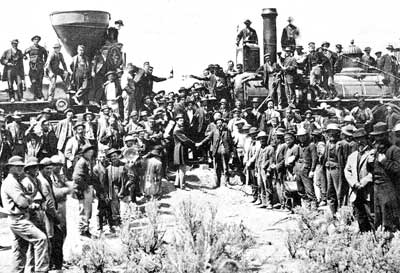 As wagon feeder roads were replaced with
railroad lines transportation in the West became faster and more luxurious. The
famous 'Pullman' car and 'Silver Palace' cars provided relatively smooth rides.
The railroad changed economy and ecology in the West. Competition for railroad
line courses was great and brought boom or bust. The bison herds were divided
forever and settlers invaded American Indian lands.
As wagon feeder roads were replaced with
railroad lines transportation in the West became faster and more luxurious. The
famous 'Pullman' car and 'Silver Palace' cars provided relatively smooth rides.
The railroad changed economy and ecology in the West. Competition for railroad
line courses was great and brought boom or bust. The bison herds were divided
forever and settlers invaded American Indian lands.
The initial trains brought out West were wood burning steam locomotives since there was initially little coal in the West but plenty of timber. The Eastern trains had begun to run on coal. In fact in the meeting of the two trains at Promontory, Utah notice the steam engine on the left has huge funnel shaped stack that is distinctive of a early wood burner, while the engine on the right is a coal burner. As steam trains evolved at first for passenger service and then freight they became larger and faster. The 'Pullman" sleeping car increased convenience and luxury such that it normally took only 10 days from St. Louis to California. The wagon trips were three-six months and express horse drawn coaches 18-30 days. In the early 20th century steam trains developed streamliners like the California Zephyr and the Daylight to provide similar service in 13- 26 hours. During WWII the largest steam locomotive the 'Big Boy" was developed to transport wartime equipment over the Rocky Mountains. Steam trains ran into the 1950s and were replaced by diesel and electric trains. Unfortunately, America went with the automobile and interstates for passenger and freight service in the 1950s and 1960s. American railroads technologically fell behind and have never recovered. Even Walt Disney envisioned high speed monorail service but it never came to be. More money was to be had producing autos, aircraft and the voracious quantities of fuel they demanded.
Trains: Steam trains are designated by their wheel
pattern/ # front pilot wheels / # drive wheels/ # rear pilot wheels;
e.g. The classic Berkshire engine is 2-8-4
 |
All the modes of transportation discussed were some form of land travel. Some decided to get to the West via boat or ship. Initially the journey around South America was grueling and fraught with danger. Juan Cabrillo first made the journey from Guatemala to San Diego, California (he called it San Miguel) in 1542. Sailing ships at that time had a very limited capability of sailing close to the direction of the wind, in fact there were only about 180 degrees that could used. Therefore sailing north along California's coast was difficult and required tacking to get wind and since the fog was extensive many ships ran aground. In fact Chumash Indian planked canoes, 'tomols', were considered faster and safer for coastal travel than Spanish sailing vessels. As with land travel technological innovation brought improvements. The great Boston ships that came around in the 1800's were the peak of sail technology. They came for sea otter trade and later brought people into the California gold fields. In 1845 Richard Henry Dana wrote of his experiences on a merchant ship, called Two Years Before the Mast. Eventually steam and diesel came on the scene. San Diego, San Pedro, San Francisco and Seattle became greater commercial and Naval harbors of the West coast. Often ferry boat services added connections between various waterways and the railroads often operated these boat services. In San Francisco the Central Pacific Railroad interconnected the vast San Joaquin Delta between the capital in Sacramento, Stockton, Oakland, San Francisco. Seattle/Tacoma developed a ferry system for Puget Sound.
Airplanes were developed at the beginning of the 20th
century in conjunction with the automobile. Initially the
airplane was for longer distances for mail services, military,
aerial photography and eventually passenger service. Lindberg's "Spirit of St.
Louis" was developed and built by Ryan Air in San Diego. Howard Hughes,
originally from Texas flew in air races and developed his "Spruce Goose" in
California. Many airplane companies located their companies in the West for the
space and year-round weather for flying. These are a few of the companies but
most have consolidated and merged in recent years. However, with new high speed
aircraft the West is still the primary test area, especially in remote desert
regions. The downside is that weapons test has taken its toll on cultural and
natural resources. Air races have become popular in recent years in which you
can see some of the WWII aircraft like P-51 Mustangs racing around courses
outside of places like Reno, Nevada.
Airships, blimps or dirigibles had a short history and one sees the Goodyear
Blimp at sports events today. At California's Moffett Federal Airfield
USS Macon ZRS-5
 that was built by the Goodyear-Zeppelin Corp
was housed in a huge hanger.
that was built by the Goodyear-Zeppelin Corp
was housed in a huge hanger.
 In 1935the USS Macon crashed off of Pt. Sur, California. Recently, in 2006, a
expedition of under sea probes found the wreckage of the USS Macon and some
of its Sparrowhawk airplanes on the ocean floor.
In 1935the USS Macon crashed off of Pt. Sur, California. Recently, in 2006, a
expedition of under sea probes found the wreckage of the USS Macon and some
of its Sparrowhawk airplanes on the ocean floor.
Automobiles emerged in the early part of the 20th century
and served for local travel in the West. However, it was not until the 1950s
that interstates were built and the automobile displaced the railroad, including
urban rail services. This displacement was more dramatic in the American West,
where in cities like Denver, Los Angeles, San Diego, etc. old trolley/bus
systems were lost. San Francisco's famous Cable Car
 was
kept merely as a tourist attraction. In California the car including the convertible and hot
rods became the rage. Racing was popular throughout the country but drag racing
was born in California. Top speed runs were made at the Bonneville Salt Flats
but the streets of Southern California with warm nights were the breading
grounds for drag racing and motorcycle clubs. In 1949 at the Goleta Air Base,
Santa Barbara, CA were the first 1/4 mile drag races. In the 1950s Pomona, CA
became a drag racing hub with early hot rods
was
kept merely as a tourist attraction. In California the car including the convertible and hot
rods became the rage. Racing was popular throughout the country but drag racing
was born in California. Top speed runs were made at the Bonneville Salt Flats
but the streets of Southern California with warm nights were the breading
grounds for drag racing and motorcycle clubs. In 1949 at the Goleta Air Base,
Santa Barbara, CA were the first 1/4 mile drag races. In the 1950s Pomona, CA
became a drag racing hub with early hot rods and later AA fuel dragsters
and later AA fuel dragsters
 and
funny cars
and
funny cars![]() .
The National Hot Rod Association (NHRA) formed in 1951 and the Pomona
Winternationals are still a popular event
.
The National Hot Rod Association (NHRA) formed in 1951 and the Pomona
Winternationals are still a popular event

 .
Sports cars and road racing also were popular in California again with the
weather and the fact that foreign cars became more popular on the East and West
coasts. Early Porsche, MG
.
Sports cars and road racing also were popular in California again with the
weather and the fact that foreign cars became more popular on the East and West
coasts. Early Porsche, MG ,
Alpha Romeo and more exotics like Ferrari became more common after WWII. The
Sports Car Club of America (SCCA) started after the war and sponsored amateur
races at places like Laguna Seca in Monterey California.
,
Alpha Romeo and more exotics like Ferrari became more common after WWII. The
Sports Car Club of America (SCCA) started after the war and sponsored amateur
races at places like Laguna Seca in Monterey California. James Dean was on his way to Laguna Seca from Hollywood to race his new Porsche
when he was killed on the trip to Monterey.
James Dean was on his way to Laguna Seca from Hollywood to race his new Porsche
when he was killed on the trip to Monterey. Today, our freeways are congested and Rap singers and movie stars prefer a
Lamborghini
Today, our freeways are congested and Rap singers and movie stars prefer a
Lamborghini
 because
of the cool doors. Nobody can really drive as fast as these cars go. The rail
system is coming back and we may see all kinds of changes in modes of
transportation in the emerging 21st century. Since the American West is so
expansive it may be too expensive to build more efficient public rail, auto
carriers, etc. Automobiles with robotic controls may get developed to go faster
and safer. We need vehicles that do not require wheels.
because
of the cool doors. Nobody can really drive as fast as these cars go. The rail
system is coming back and we may see all kinds of changes in modes of
transportation in the emerging 21st century. Since the American West is so
expansive it may be too expensive to build more efficient public rail, auto
carriers, etc. Automobiles with robotic controls may get developed to go faster
and safer. We need vehicles that do not require wheels.
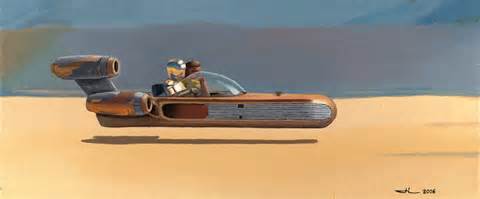 |
 |